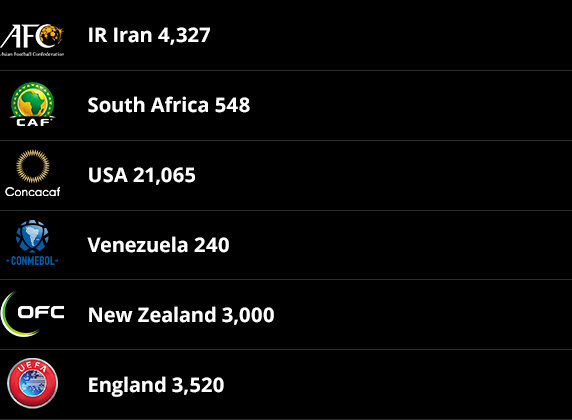
Women’s Football
Women’s football team attracts 53,000 fans... 100 years ago
The last year has been monumental for women’s football. Since more than 1 billion people tuned in to the FIFA Women’s World Cup 2019™ in France, leagues and internationals have seen a rise in attendances and viewership around the world. And yet, such heightened interest is not the new phenomenon it may appear.


A little over 100 years ago, a team of English female factory workers played in front of crowds of over 50,000, touring the USA and playing the first women’s international matches in Europe, pioneering the sport for women – all while wearing their signature bobble hats.
Trailblazers
The Dick, Kerr Ladies FC took their name from the factory where the players worked in 1917, the team having been established to improve the health of workers and to raise money for a new hospital. Their first game, on Christmas Day, attracted 10,000 spectators to Deepdale, home of Preston North End. When they played St Helens Ladies three years later at Goodison Park, an incredible 53,000 people flocked to watch.
They reached peak popularity in 1921, featuring on cinema newsreels nationwide as they played more than 60 matches, all while still working full-time at the munitions factory and receiving no payment for their footballing talents.
Among them was Lily Parr, who joined the team at just 15 years old. Renowned for her powerful shooting, it is said she actually broke the arm of a male goalkeeper who got in the way of one of her thunderous shots. Over 31 years playing for the team, she scored around 1,000 goals. To mark her incredible contribution to the game, she was the first woman to be inducted into The FA’s Hall of Fame in 2002 and a life-sized bronze sculpture of her was unveiled at the National Football Museum in Manchester in 2019.

First women’s international
Back in 1920, the Dick, Kerr Ladies’ fame was spreading and they became the first women’s team to play an international fixture when they hosted a team from Paris at Deepdale. The game attracted 25,000 spectators – a record at that time for a stadium whose men’s team were FA Cup and English Football League champions.
They also played the French ladies at Stamford Bridge in London, before touring 2,000 miles to contest return fixtures in Paris, Le Havre, Roubaix and Rouen in front of 62,000 spectators. All the revenues from their games went to charity.
Dreams cut short
With men’s football expanding in the post-war years, however, The FA became wary of the threat of the blossoming women’s game. In December 1921, The FA told clubs to refuse to let women use their stadiums any more, stating: “the game of football is quite unsuitable for females and ought not to be encouraged”. The ban would only be lifted in 1971.
Undeterred, the Dick, Kerr Ladies set off on another international tour soon afterwards, travelling to Canada and the USA. On arrival in Canada, however, the ruling Dominion Football Association prevented them from playing any games in the country because it “objected to female footballers”. In the USA, meanwhile, the authorities said they could only play against men’s teams. Disappointed but determined to prove themselves, the ladies agreed to play and ended up with a respectable record of three wins, three draws and three losses.
On their return home, however, deprived of access to established stadiums, the popularity of the women’s game quickly fell away. In 1926, the team changed its name to Preston Ladies, who continued playing fixtures until 1965, when they were disbanded due to a lack of players. In all, they played 833 games, winning 759, drawing 46 and losing just 28, at one stage going an amazing 300 games without defeat.
A new dawn
The introduction of the FIFA Women’s World Cup™ in 1991 offered a chance for the game to gain global popularity and progress has since been steady, with some inspiring highs along the way. When Brandi Chastain hit the winning penalty in the FIFA Women’s World Cup USA 1999™ final and fell to her knees in iconic celebration, it was in front of 90,000 spectators – the biggest gathering for a female sporting event in history.
Some 20 years later, that record attendance of 53,000 from 1920 was finally broken. In March 2019, 60,739 fans watched Barcelona beat Atlético Madrid, setting a new attendance record for women’s club football, almost a century after the ladies from the Dick, Kerr factory took to the pitch in their hooped bobble hats.
With women’s football globally more popular than ever before, it is unlikely it will take another 100 years for the record to be broken once more.
Women’s football across the confederations
While just a handful of women’s teams even existed a century ago, the game is unrecognisable today, with an ever-growing level of participation across the world. The FIFA Women’s World Cup 2019 did much to inspire girls and women to follow their passion for football and take up the sport. They are not just signing up to play, but also to coach and officiate in an increasing number of competitions at all levels.
Highest number of female coaches:
Highest number of female referees:
(Source: FIFA Women’s Football Member Associations Survey Report 2019)







